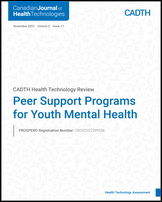|
Self-stigma
| Conley et al. (2020)39 and Hundert et al. (2021)40 (associated) | Results of all participants (n analyzed = 117 at baseline [T0]), 107 at post-intervention [T1], 97 at post-booster [T2])39 SSMIS-SF Agreement with stereotypes, mean (SD) at T0 vs. T1 vs. T2: HOP-C = 2.71 (1.56) vs. 2.42 (1.43) vs. 2.53 (1.65) Control = 2.46 (1.03) vs. 2.55 (1.39) vs. 2.84 (1.62) Group x Time ANOVA for T0-T1-T2, p = 0.160
SSMIS-SF Application of stereotypes to self, mean (SD) at T0 vs. T1 vs. T2:HOP-C = 2.77 (1.74) vs. 2.50 (1.53) vs. 2.44 (1.50) Control = 2.67 (1.38) vs. 2.54 (1.72) vs. 2.50 (1.60) Group x Time ANOVA for T0-T1-T2, p = 0.870
SSMIS-SF Harm of stereotypes to self, mean (SD) at T0 vs. T1 vs. T2:HOP-C = 3.23 (2.08) vs. 2.49 (1.65) vs. 2.43 (1.56) Control = 2.92 (1.75) vs. 3.02 (2.08) vs. 2.72 (2.12) Group x Time ANOVA for T0-T1-T2, p = 0.047; T0-T1, p = 0.019; T0-T2, p = 0.097
Results of the 2- month follow-up analysis in a population subset from 1 university (n analyzed = 55 at all timepoints; baseline [T0], post-intervention [T1], 2 months follow-up [T4])40SSMIS-SF Agreement with stereotypes, mean (SD) at T0 vs. T1 vs. T4: HOP-C = 2.01 (0.78) vs. 1.97 (0.92) vs. 1.99 (0.96) Control = 2.41 (0.88) vs. 2.51 (0.98) vs. 2.59 (1.14) Group x Time ANOVA for T0-T1-T4, p = 0.690
SSMIS-SF Application of stereotypes to self, mean (SD) at T0 vs. T1 vs. T4:HOP-C = 2.57 (1.41) vs. 2.67 (1.58) vs. 2.71 (1.54) Control = 2.80 (1.32) vs. 2.88 (1.48) vs. 3.10 (1.68) Group x Time ANOVA for T0-T1-T4, p = 0.868
SSMIS-SF Harm of stereotypes to self, mean (SD) at T0 vs. T1 vs. T4:HOP-C = 3.08 (1.88) vs. 2.59 (1.78) vs. 2.74 (1.76) Control = 3.25 (1.83) vs. 3.40 (2.04) vs. 3.61 (2.40) Group x Time ANOVA for T0-T1-T4, p = 0.306
|
| Mulfinger et al. (2018)50 | Results of all participants (n analyzed = 98 at baseline [T0], 84 at post-intervention [T1], 62 at follow-up [T2])50 Between-group analyses were conducted using linear MMRM. ISMI, mean (SD) at T0 vs. T1 vs. T2 HOP = 2.38 (0.62) vs. 2.18 (0.56) vs. 2.04 (0.48) Control = 2.30 (0.54) vs. 2.32 (0.48) vs. 2.33 (0.57) Mean between-group difference (95% CI) for change from T0 to T1 = –0.16 (–0.33 to 0.01), p = 0.058 Mean between-group difference (95% CI) for change from T0 to T2 = -0.35 (–0.54 to –0.05), p < 0.001
SSMIS, mean (SD) at T0 vs. T1 vs. T2HOP = 21.57 (8.58) vs. 17.09 (7.43) vs. 15.16 (7.37) Control = 20.63 (7.64) vs. 20.11 (8.75) vs. 20.21 (10.23) Mean between-group difference (95% CI) for change from T0 to T1 = -2.93 (-5.35 to -0.52, p = 0.018 Mean between-group difference (95% CI) for change from T0 to T2 = -5.14 (-8.22 to -2.05), p = 0.01
|
|
Stigma stressa
Perceived harm minus perceived resources
| Conley et al. (2020)39 and Hundert et al. (2021)40 (associated) | Results of all participants (n analyzed = 117 at baseline [T0]), 107 at post-intervention [T1], 97 at post-booster [T2])39 Stigma as a stressor (perceived harm), mean (SD) at T0 vs. T1 vs. T3 HOP-C = 4.22 (1.52) vs. 3.74 (1.46) vs. 3.63 (1.58) Control = 4.57 (1.21) vs. 4.16 (1.49) vs. 3.93(1.56) Group x Time ANOVA for T0-T1-T3, p = 0.922
Perceived resources to cope with stigma stress: ), mean (SD) at T0 vs. T1 vs. T3HOP-C = 4.68 (1.11) vs. 5.41 (0.98) vs. 5.48 (1.15) Control = 4.83 (1.22) vs. 4.93 (1.21) vs. 4.82 (1.37) Group x Time ANOVA for T0-T1-T2, p = 0.001; T0-T1, p = 0.001; T0-T2, p = 0.001
Note: A calculated stigma stress score (perceived harm minus perceived resources) were not reported in the study.39Results of the 2- month follow-up analysis in a population subset from 1 university (n analyzed = 55 at all timepoints; baseline [T0], post-intervention [T1], 2 months follow-up [T4])40 Stigma Stress, mean (SD) at T0 vs. T1 vs. T3 HOP-C = –0.31 (2.02) vs. –1.39 (1.56) vs. –1.97 (1.74) Control = –0.44 (1.89) vs. –0.83 (2.18) vs. –1.27 (1.82) Group x Time ANOVA for T0-T1-T4, p = 0.285
|
| Mulfinger et al. (2018)50 | Results of all participants (n analyzed = 98 at baseline [T0], 84 at post-intervention [T1], 62 at follow-up [T2])50 Between-group ITT analyses were conducted using linear MMRM. Stigma Stress Scale, mean (SD) at T0 vs. T1 vs. T2 HOP = –0.07 (2.37) vs. –2.33 (1.91) vs. –2.56 (1.95) Control = –0.35 (2.13) vs. –0.29 (2.01) vs. –0.28 (2.09) Mean between-group difference (95% CI) for change from T0 to T1 = –2.06 (–2.70 to –1.42), p <0.001 Mean between-group difference (95% CI) for change from T0 to T2 = –2.16 (–2.89 to –1.43), p < 0.001
|
